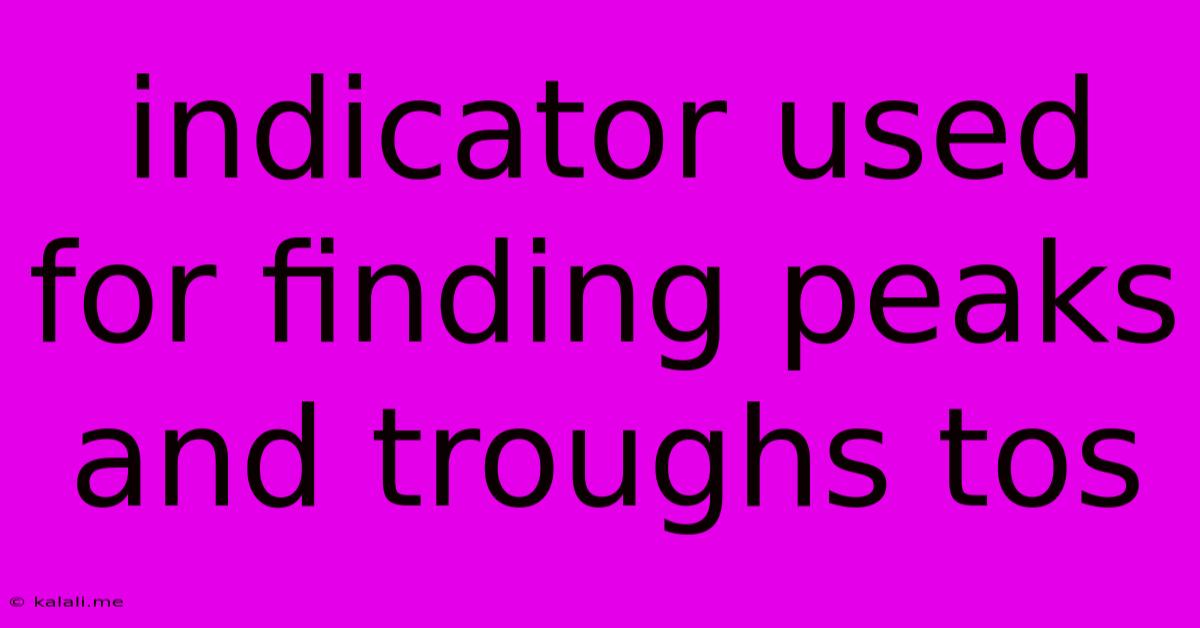Indicator Used For Finding Peaks And Troughs Tos
Kalali
Jun 02, 2025 · 3 min read

Table of Contents
Identifying Market Peaks and Troughs: A Guide to Key Indicators
Finding market peaks and troughs is crucial for successful trading and investment. While predicting the exact top or bottom is impossible, using various indicators can significantly improve your chances of identifying potential turning points. This article explores several key indicators used by traders and investors to pinpoint peaks and troughs in the market, offering insights into their strengths and limitations.
Understanding Market Peaks and Troughs
Market peaks represent the highest point in a price trend before a reversal, while troughs represent the lowest point before an upward trend begins. Identifying these points allows investors to potentially maximize profits by buying low (at troughs) and selling high (at peaks). However, it's important to remember that these are potential turning points, and the market can always surprise.
Technical Indicators for Peak and Trough Detection
Several technical indicators can assist in identifying potential peaks and troughs. Each has its own strengths and weaknesses, and using a combination of indicators often provides a more robust analysis.
1. Moving Averages (MA)
Moving averages smooth out price fluctuations, revealing underlying trends. Commonly used MAs include simple moving averages (SMA) and exponential moving averages (EMA). A bullish crossover occurs when a shorter-term MA crosses above a longer-term MA, suggesting a potential upward trend and a possible trough. Conversely, a bearish crossover, where a shorter-term MA crosses below a longer-term MA, signals a potential downward trend and a possible peak. The choice of MA periods (e.g., 50-day MA, 200-day MA) depends on the timeframe and trading strategy.
2. Relative Strength Index (RSI)**
The RSI is a momentum oscillator that measures the magnitude of recent price changes to evaluate overbought or oversold conditions. RSI values above 70 generally indicate an overbought market, suggesting a potential peak and a possible price correction. Values below 30 suggest an oversold market, hinting at a potential trough and a possible price rebound. However, RSI divergences (price making higher highs while RSI makes lower highs, or vice versa) can provide stronger signals.
3. MACD (Moving Average Convergence Divergence)**
MACD is a trend-following momentum indicator that shows the relationship between two moving averages. A bullish signal often appears when the MACD line crosses above the signal line, suggesting a potential upward trend and a possible trough. A bearish signal occurs when the MACD line crosses below the signal line, indicating a potential downward trend and a possible peak. Histograms accompanying the MACD lines can further strengthen the signals.
4. Stochastic Oscillator**
The stochastic oscillator compares a security's closing price to its price range over a given period. It oscillates between 0 and 100. Readings above 80 typically indicate an overbought condition, suggesting a potential peak. Readings below 20 suggest an oversold condition, indicating a potential trough. Similar to RSI, divergences can be highly valuable signals.
Combining Indicators for Enhanced Accuracy
Relying on a single indicator can be risky. Combining several indicators provides a more comprehensive view and increases the probability of accurately identifying peaks and troughs. For example, a bearish crossover in moving averages confirmed by an overbought RSI and a bearish MACD signal strongly suggests a potential market peak.
Limitations and Considerations
It's crucial to remember that these indicators are not foolproof. False signals can occur, and market conditions can change rapidly. Therefore, always use these indicators in conjunction with other forms of analysis, such as fundamental analysis and chart patterns, and consider factors like market sentiment and economic news.
Conclusion
Identifying market peaks and troughs is a challenging task, but utilizing technical indicators like moving averages, RSI, MACD, and the stochastic oscillator can significantly enhance your ability to pinpoint potential turning points. Remember that combining indicators, considering other forms of analysis, and managing risk are essential for successful trading and investment. The key is to develop a robust strategy that incorporates these indicators while acknowledging their limitations and the inherent uncertainty of market movements.
Latest Posts
Latest Posts
-
2015 Hyundai Sonata Limited Engine Doesnt Go Beyond 60
Jun 04, 2025
-
Kitchen Sink Drain Already Has A White Gasket
Jun 04, 2025
-
Where To Star Watching Vampire Diaries Without Missing Important Things
Jun 04, 2025
-
How To Find Average Value Of A Function
Jun 04, 2025
-
Is The Cramer Von Mises Distance A Metric
Jun 04, 2025
Related Post
Thank you for visiting our website which covers about Indicator Used For Finding Peaks And Troughs Tos . We hope the information provided has been useful to you. Feel free to contact us if you have any questions or need further assistance. See you next time and don't miss to bookmark.